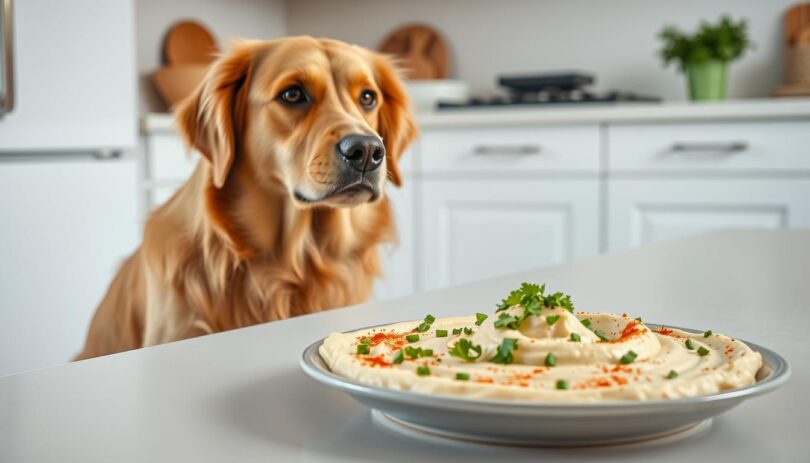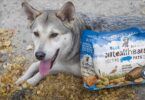What seems like a harmless snack for humans could spell trouble for your four-legged companion. While chickpea dip remains a staple in health-conscious households, its safety for pets raises critical questions every owner should consider.
This creamy spread contains ingredients that pose serious risks to canine health. Garlic, lemon juice, and tahini—common in traditional recipes—can cause digestive distress or worse. Even small amounts may lead to symptoms like vomiting or lethargy in sensitive animals.
Veterinary professionals consistently warn against sharing this popular appetizer with pets. The combination of acidic components and seasonings disrupts a dog’s digestive system differently than human metabolism. Some additives in store-bought varieties heighten these dangers through excess sodium or preservatives.
This guide breaks down each component’s effects, explores safer alternatives, and provides actionable feeding recommendations. You’ll discover expert-backed strategies to protect your pet’s well-being while maintaining their enjoyment of tasty rewards.
Understanding these nutritional boundaries helps create a safer environment for your furry family member. Let’s explore why caution matters and how to make informed decisions about your dog’s diet.
Understanding Hummus: Ingredients and Nutritional Value
Creamy and versatile, hummus packs a nutritional punch for humans but hides risks for canine companions. This Mediterranean spread combines mashed chickpeas with tahini—a paste made from sesame seeds—along with olive oil, lemon juice, and spices. A single serving offers 6-7 grams of plant-based protein and 4 grams of fiber, making it popular among health-conscious snackers.
Core Components: Chickpeas and Sesame Paste
Chickpeas form the base of this dip, providing essential nutrients like iron and folate. Tahini contributes healthy fats and a velvety texture. Together, these ingredients create a nutrient-dense snack rich in B vitamins and magnesium.
Problematic Additions in Traditional Recipes
While lemon juice adds brightness and vitamin C, its acidity can upset sensitive stomachs. Garlic—though flavorful—contains compounds toxic to pets. Store-bought varieties often include excess salt, which strains animal kidneys. Even small amounts of these ingredients disrupt canine digestion despite their benefits for people.
Owners should always check labels for hidden additives. What enhances flavor for humans might endanger four-legged family members. Balancing nutritional value with pet safety requires understanding every component in this deceptively simple spread.
Can dogs eat hummus? Debunking the Myth
Many pet owners assume this popular dip is harmless due to its plant-based foundation. Chickpeas, the primary ingredient, offer protein and fiber—nutrients that benefit pets in simple forms. However, the complete recipe transforms these safe legumes into a risky snack.
Why Hummus Might Seem Safe for Dogs
The creamy texture and mild aroma often trick owners into offering a taste. Plain chickpeas, when cooked plainly, aren’t toxic to pets. This leads to confusion about prepared variations like hummus. Store-bought versions may also market “natural” labels, implying safety.
The Real Risks Involved
Garlic and onion powder, common in recipes, damage red blood cells in animals. Research shows 15-30 grams of garlic per kilogram of body weight can cause poisoning. Lemon juice irritates sensitive stomachs, while excess salt strains kidneys over time.
Veterinary reports highlight cases where even tablespoon-sized portions triggered vomiting or diarrhea. Small breeds face heightened risks due to lower toxicity thresholds. Preservatives in commercial brands add hidden dangers, like xylitol in some flavored varieties.
Instead of sharing dips, opt for vet-approved treats. Moderation matters, but with hummus, the stakes outweigh potential benefits. Always prioritize formulas designed for canine health over human food trends.
Impact of Hummus Ingredients on Dog Health
While some human foods share nutritional benefits with pets, others hide unseen dangers beneath their savory surfaces. Common components in this chickpea-based spread trigger biological reactions that compromise animal wellness. Understanding these risks helps owners make safer choices.
The Dangers of Garlic and Onions
Garlic and onions contain thiosulfates—compounds that rupture red blood cells in animals. This oxidative damage leads to hemolytic anemia, causing weakness and pale gums. Even 0.5% of a pet’s weight in these ingredients can be toxic, according to veterinary studies.
Store-bought dips often include powdered forms that concentrate these hazards. A single tablespoon-sized lick might introduce enough toxins to require medical intervention. Symptoms like rapid breathing or dark urine signal urgent vet care.
Effects of Oil and Lemon Juice on Digestion
High-fat oils strain pancreatic functions, increasing pancreatitis risks. Olive oil becomes problematic when combined with other rich ingredients, potentially causing diarrhea or long-term weight issues. Lemon juice’s acidity irritates stomach linings, while excess salt disrupts hydration balance.
Veterinary reports show pets consuming seasoned dips often experience vomiting within hours. For safer snack options, explore low-sodium alternatives designed for canine systems. Always prioritize single-ingredient treats over complex human recipes.
Safe Feeding Practices: Healthy Alternatives for Your Canine
Pet owners seeking healthy snacks can find safer options that align with their dog’s dietary needs. Veterinarians recommend simple, single-ingredient foods over complex human recipes to avoid digestive issues.
Dog-Friendly Dips and Spreads
Plain pumpkin puree serves as a fiber-rich alternative to seasoned dips. Mix it with unsweetened yogurt for a gut-friendly snack. Unsalted peanut butter (xylitol-free) offers protein and healthy fats when spread on chew toys.
Mashed sweet potatoes or steamed carrots provide satisfying crunch and vitamins. For training rewards, blend cooked chicken with low-sodium broth into a smooth paste. These options deliver flavor without harmful additives.
Portion Control and Treat Moderation
Treats should never exceed 10% of a pet’s daily calories. Use a measuring spoon for calorie-dense foods like peanut butter. Rotate snacks to maintain nutritional balance and prevent boredom.
Store human foods like hummus in sealed containers away from counter edges. Train pets to ignore dropped items using commands like “leave it.” For more snack safety tips, explore our guide on feeding dogs safely.
Experts suggest scheduling treat times to avoid overfeeding. Always consult your vet when introducing new foods to ensure they suit your furry friend’s health needs.
Evaluating Nutritional Benefits versus Risks
Nutritional value alone doesn’t guarantee safety when sharing snacks with pets. Chickpeas—the star ingredient in hummus—offer notable health perks in their basic form. However, preparation methods and added components dramatically alter their suitability for animal consumption.
Pros and Cons of Incorporating Chickpeas
Plain chickpeas provide 15 grams of plant-based protein per cup, along with 12 grams of fiber. These legumes deliver essential minerals like iron and magnesium, supporting energy production and muscle function. When soaked and cooked without seasoning, they can serve as an occasional treat.
Combining chickpeas with tahini (sesame seed paste) introduces healthy fats but also concentrates calories. Traditional recipes amplify risks by adding garlic and acidic ingredients that irritate canine digestive systems. Even small portions disrupt nutrient absorption despite the base ingredient’s benefits.
Store-bought hummus often contains preservatives and sodium levels unsuitable for pets. While humans gain antioxidants and vitamins from this spread, animals face potential organ strain. Always prioritize single-ingredient preparations over mixed formulas for safer snacking.
Veterinary Insights on Dog Nutrition
Animal nutrition experts emphasize tailored dietary plans for pets. While occasional treats might seem harmless, ingredients in human foods often clash with canine biology. Professional guidance helps navigate these risks effectively.
When to Consult Your Veterinarian
Veterinary professionals strongly discourage sharing seasoned dips or spreads. Garlic and onion toxicity remains a top concern, with even trace amounts potentially damaging red blood cells. High sodium levels in store-bought products also risk kidney strain over time.
Watch for vomiting, diarrhea, or lethargy after accidental ingestion. These symptoms demand immediate vet attention. Smaller breeds may show reactions faster due to their size.
Regular check-ups help identify dietary sensitivities. Share your pet’s snack habits during appointments for personalized advice. For unexpected issues like accidental meat product consumption, quick action prevents complications.
Every furry friend has unique nutritional needs. Trusted veterinarians create balanced plans that prioritize health without sacrificing enjoyment. Their expertise turns guesswork into science-backed care for your companion.
Preventing Accidental Hummus Consumption
Keeping pets safe requires proactive measures beyond just avoiding intentional feeding. Securing hazardous foods and reinforcing good habits reduces risks in busy households. These strategies help create environments where curious noses stay away from dangerous snacks.
Dog-Proofing Your Kitchen
Store chickpea-based dips in locked cabinets or high shelves dogs can’t reach. Use baby gates to block kitchen access during meal prep times. Clean counter spills immediately—even small amounts containing lemon juice or salt pose threats.
In multi-person homes, label containers clearly and educate family members about risks. Consider designating pet-free zones where olive oil-rich foods or seasoned spreads remain off-limits. For added safety, keep trash cans secured with lids to prevent scavenging.
Training Your Dog to Avoid Human Foods
Teach the “leave it” command using positive reinforcement techniques. Start with low-value items and gradually introduce tempting foods during practice sessions. Reward compliance with vet-approved treats instead of table scraps.
Consistency matters—reinforce training daily and involve all household members. For persistent sniffers, redirect attention to interactive toys filled with safe snacks. Always supervise gatherings where guests might unknowingly share harmful foods.
Final Thoughts on Feeding Your Furry Friend Safely
Protecting your pet’s health starts with smart snack choices. Traditional hummus contains garlic, lemon juice, and excess salt—ingredients that threaten animal wellness. Even small quantities can cause digestive issues or blood cell damage.
Stick to simple, vet-approved treats instead. Plain chickpeas (without seasoning) or pumpkin puree offer safe alternatives. Always check labels for harmful additives in store-bought foods.
Moderation remains key when sharing any human foods. Measure portions based on your companion’s weight and nutritional needs. Treats should complement balanced meals rather than replace them.
Consult your veterinarian for personalized guidance. They’ll help identify suitable snacks and address dietary concerns. Immediate care becomes crucial if accidental ingestion occurs.
With careful planning, you can keep your furry friend both happy and healthy. Store risky dips securely, train pets to avoid counter surfing, and prioritize species-specific nutrition. Your informed decisions create a safer, tastier world for your loyal companion.
FAQ
What makes hummus potentially harmful for pets?
Garlic and onions—common in many recipes—contain thiosulfate, which damages red blood cells in canines. Lemon juice’s acidity may upset sensitive stomachs, while excess salt strains kidneys. Tahini (sesame paste) and olive oil add unnecessary fat content.
Are there any safe ways to share chickpea-based snacks?
Plain cooked chickpeas offer fiber and protein without added spices. Mash them into a spread, avoiding garlic, citrus, or sodium. Always serve sparingly—too much legume content causes gas or bloating.
How quickly should owners react if their pet eats store-bought hummus?
Contact a veterinarian immediately if garlic or onion appears in the ingredients list. Watch for lethargy, vomiting, or pale gums—signs of potential toxin exposure. For small quantities without harmful additives, monitor digestion closely.










Leave a Comment